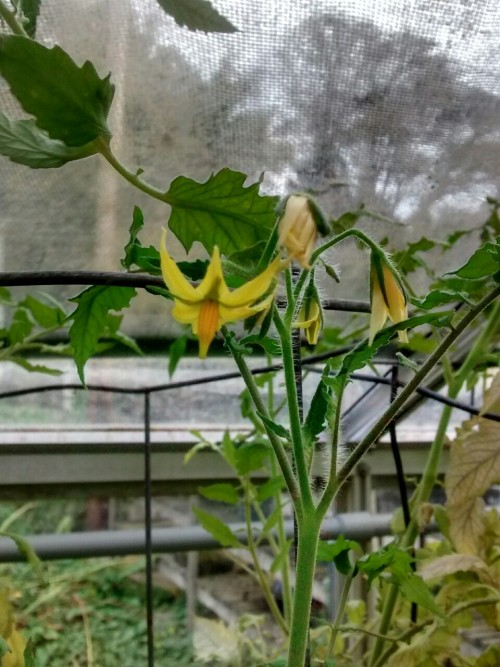A few days after the harvest moon (September 27th this year, I think), my brother and cousin carried huge zucchini into the house in armloads like firewood. We had six zucchini plants, and that never seems like too many when you're seeding them, but more than one or two zucchini plants is really Too Much Zucchini. He gave me a smaller one (it's like six inches thick and two feet long) and some cherry tomatoes, and I have no idea what I'm going to do with it. I don't really eat much these days. My mom suggested I carve the zucchini like a jack 'o lantern, which they used to do when they couldn't afford to buy pumpkins.
 |
| Left: a sink full of pickling cukes that turned into little blimps. Right: a row of zucchini, and in front of them a row of Long English cucumbers. |
My cousin spent his day off peeling the sink full of pickling cukes so he could slice them and make basically every sliced pickle recipe he could come up with. They got big enough that the skins were too tough to leave on. His mom came over and helped him for a while. I would have helped too, but I didn't know it was happening until it was already finished, because I went to bed at 6am.
He intends to mix the Long English cucumbers and zucchini together and grate them and make yellow relish, and chocolate zucchini cake, and soup, and anything else he can think of. I made zucchini marmalade one year. I think they have a food processor up there, but he's still going to be grating and canning and bagging (you can freeze grated zucchini in flat ziploc bags) for a long time.
 |
| Long English cucumbers that got too big and yellow. I didn't even realise we had that many in there. |
We tried the Long English cucumbers that went yellow, and I was expecting them to be bitter and inedible, but they were actually alright. My cousin said they tasted sort of like watermelon, and my brother said they tasted like the watermelon rind (they were pretty hard), and I told them about pickling watermelon rind with the green skin cut off when I was a teenager. I used to pickle anything that would hold still long enough, because not having anything to eat was a real fear. I don't know how I found the energy to do all that, but it's probably still in the cellar that nobody goes into because it's extremely creepy and the light doesn't work. My mom and grandmother and p much every female relative I have known do the same thing; my mom has an amazing amount of fish in the freezer and discount dried pasta in the cupboards. We still have stacks of plastic yoghurt containers and ice-cream buckets my grandmother saved, and pickles and canned fruit she made in the nineties that nobody knows what to do with. We might need it someday. She's been gone nearly a decade.
(They ended up throwing most of the old yellow cucumbers out, though. We're not hungry enough for it to be worth the work of canning all those).
 |
| Yellow pear tomatoes in late August. |
 |
| Grape tomatoes in early August. |
None of the pics I took of the tomatoes we picked in bowls worked out, but I got some of the greenhouse a week or so before they were picked.
 |
| The tomatoes on September 17, just after I revived them. The plants were a lot yellower and more bare than they look here. |
They're in one-gallon pots and it's around 30C in the greenhouse at that time of year, so the tomatoes have to be watered a couple times a day. I was too sick to leave the house for a while, and when I eventually went out into the garden, the tomatoes were completely limp and nearly dead. I was really puzzled, because the guys had been watering them all year (and I'd been doing it occasionally), so why would they stop right before they finally produced some fruit?
I asked my cousin, and he said that they just got tired of having to water the damn things all the time on top of going to work etc. If I'd known, I might have gone out sooner, but I don't talk to them often.
I watered the tomatoes and kept watering them, and broke all the old dead leaves and extra suckers off, and they perked up pretty well. I really didn't expect them to survive, but the fruit that was already half-ripe did end up ripening. The green fruit was completely shrivelled and the flowers died, so I don't think we'll be getting any more tomatoes this year. We only got a few handfuls, and like twelve partially-eaten apples. It was not a good year for anything but zucchini and cucumber.
(Update: Actually, it's October 16th now, and the tomato plants have new flowers, so we might get a few more tomatoes.)
Unfortunately, watering the tomatoes after a period of drought made a lot of the fruit split.
 |
| They're still edible. |
 |
| Cucumber flowers in early August. |
 |
| Pickling cukes and zucchini at the end of August. That's a 4" pot for scale. |
 |
| Zucchini in late August. As soon as it rained the plants were covered in mildew, so that's it for them. |
 |
| Mildewed zucchini plants on September 17. They'd had a chance to grow some since the rain. It's now a month later, and they're definitely toast. |
Artist Ursula Vernon created the little-known anthropomorphic Saint Wombus:

St. Wombus, a little known saint of the late middle ages, achieved
fame and beatification for what came to be known as the Miracle of the
Zucchini.
Namely, there was only ever the ONE zucchini.
This feat, a sort of vegetable inversion of the loaves and fishes,
was so astonishing and obviously counter to nature that Wombus was
beatified at once.
His blessing is sought by gardeners who have foolishly overplanted.
An icon of St. Wombus, buried upside down in the vegetable patch, is
believed to keep most members of the squash family at manageable levels.
(Image and description from Red Wombat Studios)
(An anthropomorphic Christian saint is really not that far-fetched; see
cynocephaly. Some saints were popularly depicted with the heads of dogs in Russian Orthodox traditions, especially St. Christopher).
When my cousin brought me down an armload of vegetables, he threw a
frozen salmon steak he had caught and packaged on top because they have way too
much fish in the freezer. And then they all sat on the porch in the evening sun
drinking cranberry Canada Dry ginger ale mixed with vodka. It was extremely
Canadian.
Mixing cranberry Canada Dry with vodka and some fruit (blackberries or raspberries in summer) and ice in a large glass or mason jar is really popular (the guys upstairs go for the mason jar), but the soda itself is pretty much the official
special occasion drink of children and people who don't drink in Canada. As far as I can remember, we only had it at birthday dinners and
Christmas when I was a kid, so it was pretty fancy.
The soda is a reddish-pink colour, like the can. The colour is 98% of the appeal; I don't remember it tasting any different from regular ginger ale.
If you look up recipes for non-alcoholic drinks made with cranberry Canada Dry, you'll find them mostly on mom blogs and food blogs. They have some fantastic photography of very pretty drinks, but I won't use it without permission.
(Putting cranberries in Christmas drinks made with cranberry gingerale is popular in online recipes, but nobody actually likes eating raw cranberries and they're kind of a pain to drink around, so another sort of berry is probably a better bet.)













No comments:
Post a Comment